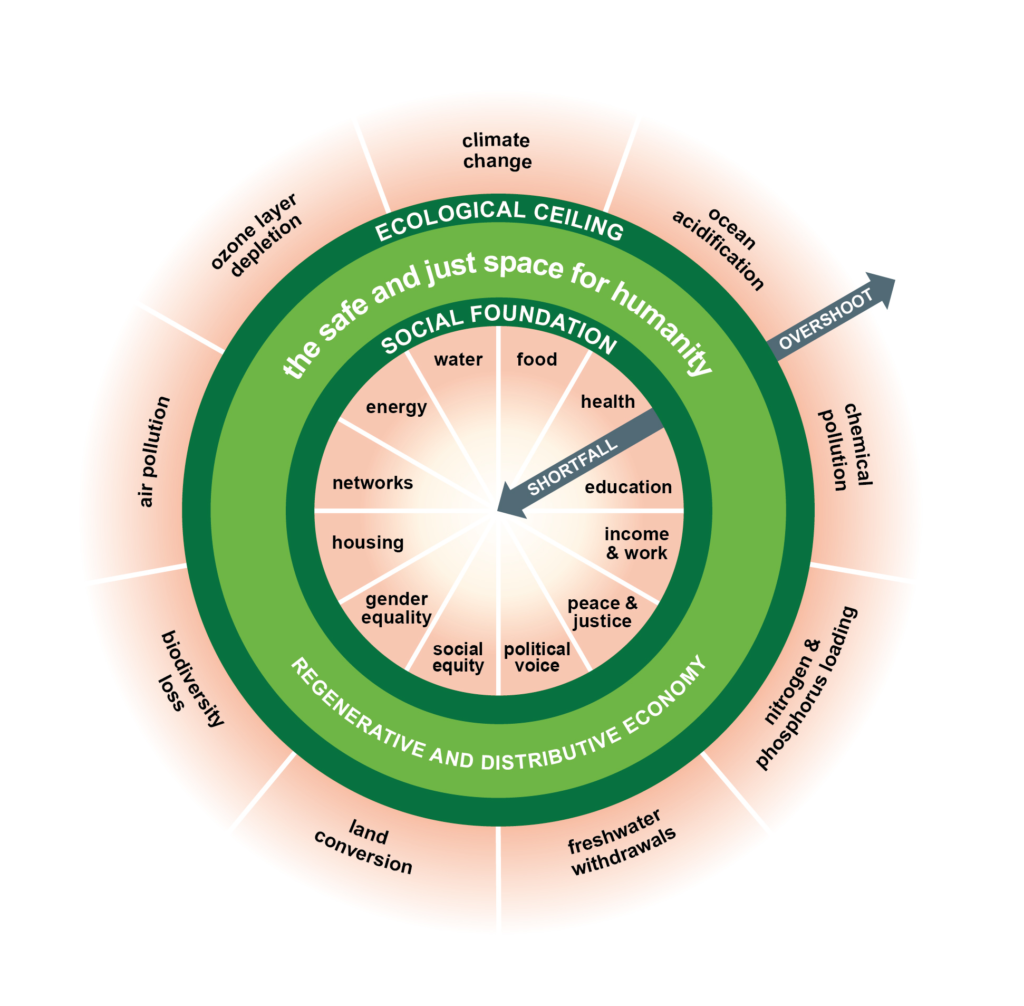Introduction
The doughnut model is a framework for sustainable development that was proposed by economist Kate Raworth in her 2017 book Doughnut Economics: Seven Ways to Think Like a 21st-Century Economist. The model is based on the idea that a sustainable society must provide for the basic needs of all its members while also staying within the limits of the planet’s ecological resources.
The doughnut model is divided into two concentric circles. The inner circle represents the social foundation, which includes the basic needs that all people must have in order to live a good life, such as access to food, water, shelter, healthcare, and education. The outer circle represents the environmental ceiling, which represents the limits of the planet’s ecological resources, such as the amount of carbon dioxide that can be emitted into the atmosphere or the amount of fish that can be caught from the oceans.
The space between the two circles represents the “doughnut hole,” which is the area where a sustainable society must operate. This means that a sustainable society must provide for the basic needs of its members while also staying within the limits of the planet’s ecological resources.
Sustainable Mobility Planning
The doughnut model can be used to guide sustainable mobility planning. Mobility is a key aspect of human life, and it is essential for people to be able to move around in order to access jobs, education, healthcare, and other essential services. However, mobility also has a significant environmental impact. Transportation is a major source of greenhouse gas emissions, and it also contributes to air pollution, noise pollution, and traffic congestion.
Sustainable mobility planning seeks to reduce the environmental impact of transportation while also ensuring that people have the mobility they need. The doughnut model can be used to guide sustainable mobility planning by focusing on the following three key areas:
- Equity: Sustainable mobility planning must ensure that everyone has access to mobility, regardless of income, race, or gender. This means providing affordable public transportation options and making sure that streets are safe for people to walk and bike.
- Efficiency: Sustainable mobility planning must make the most efficient use of resources. This means investing in public transportation, walking, and biking infrastructure, and making sure that cars are used efficiently.
- Environmental sustainability: Sustainable mobility planning must reduce the environmental impact of transportation. This means reducing greenhouse gas emissions, air pollution, and noise pollution.
The Doughnut Model in Practice
The doughnut model has been used in a number of cities and regions around the world to guide sustainable mobility planning. For example, the city of Copenhagen in Denmark has used the doughnut model to develop a comprehensive plan for sustainable mobility. The plan includes a number of measures to reduce the environmental impact of transportation, such as investing in public transportation, expanding the city’s bicycle network, and making streets safer for pedestrians.
Another example of the doughnut model in practice is the city of Oslo in Norway. Oslo has set a goal of becoming the world’s first carbon-neutral capital city by 2030. The city is using the doughnut model to guide its transportation planning, with a focus on reducing car traffic and increasing the use of public transportation, walking, and biking.
Doughnut Model Overview:

The doughnut model is a simple but powerful tool for understanding and planning sustainable development. The model can be used to assess the sustainability of any system, from a city to a country to the entire planet.
The inner circle of the doughnut represents the social foundation, which includes the basic needs that all people must have in order to live a good life. The outer circle represents the environmental ceiling, which represents the limits of the planet’s ecological resources. The space between the two circles represents the “doughnut hole,” which is the area where a sustainable society must operate.
To achieve a sustainable society, we need to ensure that everyone has access to the basic needs represented by the inner circle, while also staying within the limits of the environmental ceiling represented by the outer circle. This means that we need to find ways to reduce poverty, inequality, and environmental degradation.
A doughnut model is a helpful tool for identifying the areas where we need to focus our efforts to achieve a sustainable society. It can also help us to measure our progress towards sustainability.
Conclusion
A doughnut model is a powerful tool for sustainable mobility planning. It can help cities and regions reduce the environmental impact of transportation while also ensuring that everyone has access to the mobility they need. The doughnut model is still a relatively new framework, but it is gaining popularity around the world. As more cities and regions adopt the doughnut model, it will become an increasingly important tool for sustainable development.














